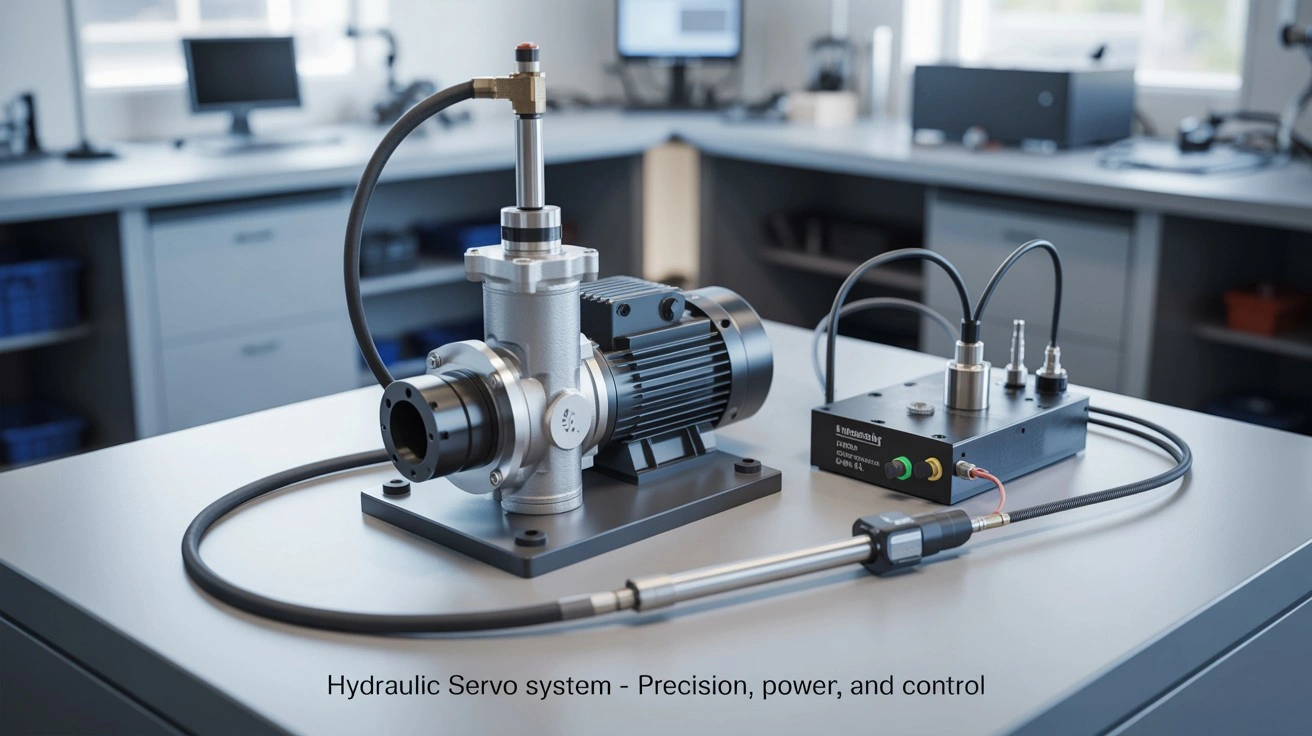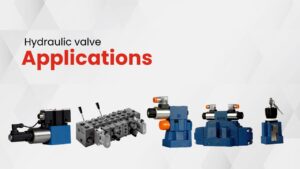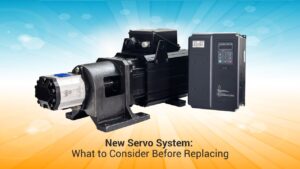Hydraulic systems have withstood the test of time across industries that require reliability, power, and precision. In conjunction with servo technology, their performance is enhanced, providing high-precision positioning and control for a wide range of applications, including aerospace, robotics, heavy machinery, automotive testing, and more. Thus, a hydraulic servo system combines the force advantage of hydraulics with the precision offered by servo controls, which is why they are found in almost every industrial sector that requires both.
In this Blog, we will cover the basic concept of a hydraulic servo system, its main components, functionality, and why it remains an important component in modern engineering applications.
What is a Hydraulic Servo System?
A hydraulic servo system is a sophisticated control system that utilizes pressurized fluid and servo mechanisms to regulate the movement and position of mechanical elements. This system integrates a hydraulic power source, sensors, and servo-controlled valves for fast responses and high precision.
Whereas traditional hydraulic systems work rather like an on/off switch, servo systems permit proportional and indeed, very fine control of movement, so the output closely follows the input command.
The systems have widespread use wherever speed, force, and precision have to go hand-in-hand. Such as flight simulators, machine tools, automotive test rigs, and industrial automation.
Core Principles of a Hydraulic Servo System
It is based on three principles. What are they?
Hydraulic Actuation: Hydraulic pressure is converted to motion or force through actuators.
Closed-Loop Control: Closed-loop systems receive actual movement data constantly fed back to the control system for comparison with the command.
Accurate Control: Servo valves and controllers precisely automate the flow and pressure of hydraulic fluid.
The combination of hydraulics and electronic control ensures both high capacity and the most reliable performance possible.
Key Components of a Hydraulic Servo System
In a hydraulic servo system, the key components are represented as follows:
Servo Motor Hydraulic Pump
The flow of pressurized hydraulic fluid is generated by a hydraulic pump driven by a servo motor. Servo-driven units are speed-variable based on load, in contrast to fixed pumps. It makes them energy-efficient and extremely responsive. A servo motor guarantees that the pump output is in perfect step with the system.
Hydraulic Flow Control Valve
It is the hydraulic flow control valve at the heart of precision regulation. Regulates the volume and flow direction of the fluid entering the hydraulic cylinder. They are designed to respond immediately to input signals, while providing a stable trajectory error response; this is especially important in the context of motion control, such as servos used in robotics, where smooth and proportional motion behavior is desired.
Hydraulic Cylinder
The hydraulic cylinder uses hydraulic energy to transform it into linear mechanical motion. Cylinders in a servo system are controlled because they need to reach exact positions with precise forces. They dare to have an edge over electric actuators by providing extremely high power density whilst maintaining high resolution.
Low-Cost Linear Position Sensor
Without sensors, you will never achieve accurate positioning. The movement and displacement of the hydraulic cylinder mop piston are measured with a cheap linear position sensor. This data is being continuously looped back into the controller. By comparing the actual movement with the commanded input, the low-cost linear position sensor eliminates errors and closes the loop with high accuracy.
Electronic Controller
The electronic controller is what integrates the system, and it wasn’t of a hydraulic nature. It receives incoming signals, compares them to the desired data, and instructs the valves and actuators on the necessary steps to follow. It is this electronic intelligence that distinguishes servo systems from traditional hydraulic circuits.
How Does a Hydraulic Servo System Work?
The working of a hydraulic servo system
Input signal: The system can receive an input signal from either an operator, a machine controller, or a system test rig.
Servo Motor Hydraulic Pump Activation: A pump enabled by a servo motor, the servo motor drives the pump to prepare high-pressure hydraulic fluid.
Flow Regulation: The hydraulic flow control valve accurately measures the fluid, allowing for controlled flow to enter the cylinder and also regulates flow direction.
Sensor Output: The hydraulic cylinder transforms controlled tail fluid power into linear or rotary motion, depending on the layout.
Feedback Loop: The controller receives immediate feedback on movement from a low-cost linear position sensor. If anything does not match, changes are made immediately.
Correct Output: The outcome is responsive, providing a frictionless, efficient, and precise command response, even under unsteady loads and rapid variations.
This closed-loop is what servo hydraulics is all about: self-correcting and maintaining high fidelity between input and output.
Applications of Hydraulic Servo Systems
Hydraulic servo systems are integral where power and precision must co-exist. Some common applications include:
- Aerospace: Aircraft simulators, actuation of flaps, and flight control systems.
- Industrial Machinery: Precision cutting, forming, and material handling equipment.
- Automotive: Suspension testing rigs, brake testing, and crash test equipment.
- Robotics: Heavy-duty robotic arms requiring both delicacy and strength.
- Defense: Missile control systems and tank turrets, where precision movement is vital.
These applications underscore why servo systems remain essential, despite the emergence of electric alternatives. Hydraulics still offer unmatched force density and durability, while servo controls bridge the gap for precision.
Advantages of Hydraulic Servo Systems
- High Power-to-Size Ratio: Delivers immense force from relatively compact units.
- Smooth Control: Offers gradual and proportional movement rather than abrupt shifts.
- Quick Responsiveness: Servo components minimize delays, ensuring a seamless response to rapid input changes.
- Durability under Load: Handles shock loads and variations far better than most mechanical systems.
- Flexibility: Can be adapted to numerous applications that require either precise accuracy or brute force.
Common Challenges in Hydraulic Servo Systems
These systems are extremely effective, but have significant challenges for deployment and maintenance:
Maintenance: Requires more challenging maintenance due to its variety of valves and sensors.
Heat Production: When high loads are operated continuously, the hydraulic fluid tends to heat up rapidly, requiring cooling measures.
Vulnerability to Leakage: Without proper maintenance, hydraulic circuits can leak fluid.
High Setup Cost: Components such as servo valves and sensors can significantly increase the setup cost.
However, when properly designed and maintained, these difficulties are minimal, thus ensuring hydraulic servo systems are a trustworthy option for rugged industries.
Bottom Line
The hydraulic servo system is an intermediate state between pure hydraulic and pure electronic systems. When core components work together, strength-specific applications, despite these challenges, still play an important role in engineering today.
THM Huade offers trusted products for businesses that require dependable hydraulic solutions with innovative features and superior designs, enabling users to rely on its capabilities and performance as industry needs evolve.
FAQs
Q2. What role does the linear position sensor play in the hydraulic servo system?
Linear position sensor for real-time feedback of the mover position of an actuator. This information makes sure that the actual position corresponds to the commanded position, allowing the closed-loop controller to self-correct for accuracy.
Q3. Is it possible for hydraulic servo systems to be energy-efficient?
Yes. When paired with a servo motor hydraulic pump, these systems vary output (to the demand) and avoid energy waste, achieving higher efficiencies than traditional constant-displacement pumps.
Q4. Which industry profits from the hydraulic servo system?
The aerospace, automotive, robotics, defense, and heavy machinery sectors primarily benefit from the advantages of high precision and heavy payload requirements.


